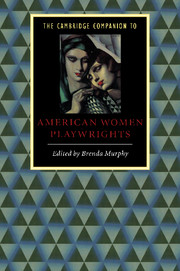Book contents
4 - Susan Glaspell and modernism
from Part 2 - Inheritors
Published online by Cambridge University Press: 28 May 2006
Summary
As for so many early twentieth-century women writers, modernism for Susan Glaspell (1876-1948) was at once a blessing and a curse. It stimulated her best work, and then scorned her aesthetic. It incorporated her theatrical innovations, and proceeded to ignore their creator. It made her reputation, but only to repudiate it. In order to understand these seeming paradoxes, that slippery term, “modernism,” or, more accurately, “modernisms,” must be defined in its gendered American historical context before we turn to Susan Glaspell herself.
Much of the exuberance of American nineteenth-century literary culture arose from the belief that art and life are indivisible. As Ralph Waldo Emerson, who greatly influenced Glaspell, concludes in “The Poet”(1842), “The poets are thus liberating gods … They are free, and they make free”(236). Although Emerson addressed his exhortations to “men,”women, too, believed that their writings would and should affect the lives of their compatriots. One of the major goals of the so-called domestic and sentimental novelists of mid-century was to evoke feeling or “sentiment”in their readers, but feeling was the means to an end, not the end itself. In her “Concluding Remarks”to her best-selling Uncle Tom’s Cabin (1852), Harriet Beecher Stowe admonished her readers, “There is one thing that every individual can do, - they can see to it that they feel right”(624), and then act upon that feeling to end slavery. When Abraham Lincoln addressed Stowe in 1863 as “the little lady who made this big war,”his condescending comment did acknowledge that Stowe’s art moved her readers to profound change in American life.
- Type
- Chapter
- Information
- The Cambridge Companion to American Women Playwrights , pp. 49 - 65Publisher: Cambridge University PressPrint publication year: 1999
- 1
- Cited by



